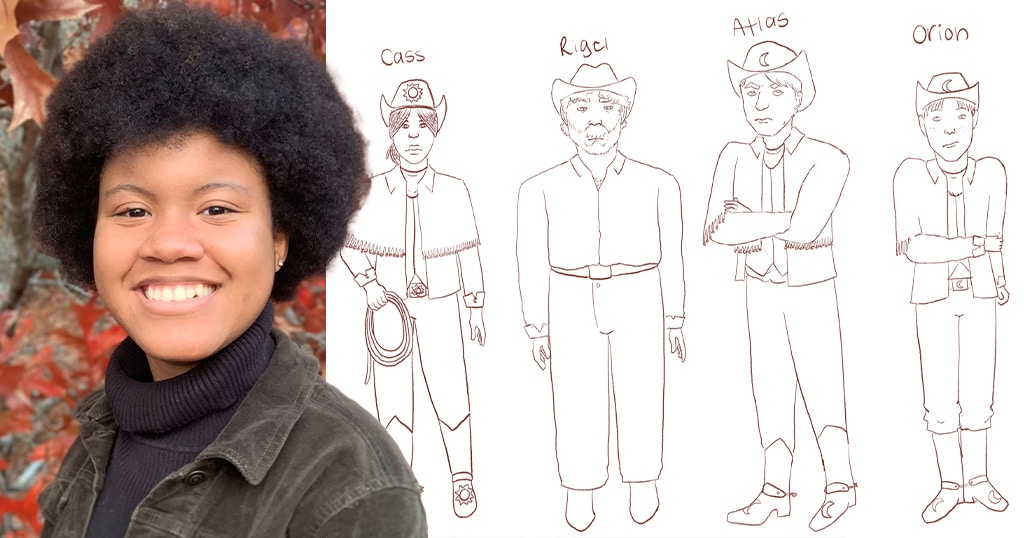Animating Digital Civilizations

Civilization 5 is the latest version of an immensely popular turn-based strategy game pioneered by game guru Meier in 1991. Just like the original game, Civ 5 challenges players to “build an empire to stand the test of time,” by taking a chosen civilization from prehistoric times into the far future. Along the way, gamers guide their people by making difficult decisions about expansion, economic development, technological change, and international relations. You can win by ruling the world through force, diplomacy, constructing utopia, or reaching the stars.
In spite of the game’s emphasis on strategy, digital artists and animators played an important role in creating the virtual world of Civ 5—so much so, that PC Gamer magazine called it “indisputably the best looking turn-based strategy game ever made.” To find out how these widely acclaimed graphics were created, we talked to animator Marlow about his work.
Q: Playing a complex game like Civilization 5, you often wonder if it took an entire civilization to build it! How many animators were there, and how big was the Firaxis team working on the game?
On Civ 5, I worked with a team of seven animators and one dynamics animator. The Civ 5 art team had two effects artists, eight 2D artists, and ten environment and character artists who did all the modeling and texturing in the game. Working with them on the core game were seventeen programmers.
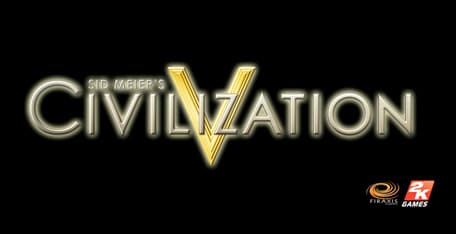
Our parent company 2K Games provided a support team in China to help with the huge number of assets that needed to be created. Because of the different stages of production not all these people worked on the game at the same time. In pre-production a lot of R&D takes place, so a smaller production team is needed while they figure out the scope and style of the product. But as the game goes into full production the team size ramps up. Pre-production time can fluctuate, but I believe Civ 5 took about two years with approximately one year of full production, for a total or three years.
Q: Greg, your role on the project was as an animator of both in-game units and leader characters. Can you give us a sense of the typical workflow for a scene that you’re animating? What software programs did you use in your daily work?
Civ offers some rather unique experiences for an animator in the game industry. For the units (the little guys), we needed a lot of animations in a short amount of time. I completed about three animations a day. The characters are small and lower resolution, so one would assume that means they are easier to animate. But actually they were very challenging since the animations needed to communicate clearly for the action to “read” for the player. The leaders were full screen and much higher resolution, so subtle details are more important. An eye dart can make or break the entire shot. A six to ten second leader animation, with speech, would take about three days.
We used 3ds Max for the project. Since I came from a Maya background, it took me a few weeks to adjust. But after you get past the interface differences, a keyframe is a keyframe, no matter which program you are using!
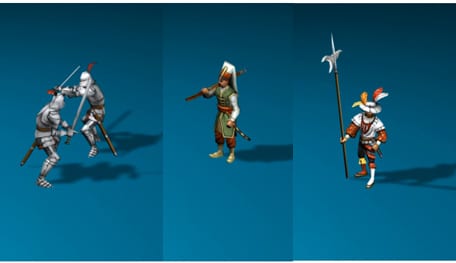
Q: What role do you as an animator play in getting the player involved in the game?
Working on the in-game units was a lot of fun. As I mentioned, they are small and often far from the game’s “camera”, so every movement they made had to be very clear from a distance. It was an interesting balance of exaggeration and realistic body mechanics. It taught me that clarity really is king. You can have all the polish and flourish in the world but if the action is not clear, it will not communicate. And if it doesn’t communicate then the animation fails to do its job.
In games, animation serves a different role than in film. In film, the animation furthers a story. In games, the animation communicates to the player whether their action was successful or not. The player needs to know if a button that was pressed worked. Did they kill the enemy? Did she jump the gorge? Did he unlock the box? It is the animation’s job to communicate that feedback to the player.
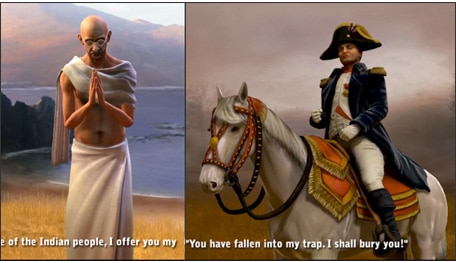
Q: Can you talk about the process of animating leader characters such as Napoleon and Ghandi. With Napoleon, for instance, what were the challenges in making his animation (in which he speaks in French) convincing and interesting? What were you aiming for and how did you achieve it?
Animating the leader characters is similar to animating a person giving a speech; the characters are monologuing. Unlike in a film, the game character is making direct eye contact with you, as the player. On top of that, the characters speak in their native language. The personality and emotion has to be clear, even though the player might not know exactly what they are saying.
To accomplish this we had to clearly define each character’s personality so we would know how they would react in any situation. The Napoleon character (and arguably the historical figure) believes himself to be the greatest general to ever live. If you declare war against Napoleon, he is not afraid. He is confident he will stomp you, so his physical acting had to express that confidence.
Gandhi, on the other hand, is simply sad when you declare war on him. He is not scared; he regrets the suffering and loss of life a war will cause. These emotions further the gameplay in different ways. You want to defeat Napoleon because he is a cocky little twerp. But you may also want to prove to Gandhi that you are not a warmonger. Or maybe you just want to destroy Gandhi for making you feel bad. (Each person is different I guess.)
Q: As I understand it, the leader scenes have been part of the game since Civ I. Did your team take previous iterations of the game (and fan preferences) into account when creating your scenes?
History provides us with only so many great well-known world leaders, and many of them are fan favorites. Almost every player loves the idea of playing as Gandhi and nuking England. But of course with five iterations of the game you run the risk of being repetitive. I think the designers did a great job of balancing fan favorites while still being able to pepper in lesser known leaders, like Askia, to keep it spiced up. But after the leaders were chosen we based most of their personalities on historical research with just a touch of Hollywood thrown in to keep them entertaining.
Q: What part of the project are you most proud of, and why?
I am very proud of all of it. But I am most proud of the stuff that was hardest earned. Askia gave me a lot of technical problems, and I really had to fight my way through that character to make his animation look good. It was the same with the Knight unit; his run was the first horse animation I did for the game, and I struggled with making it look correct. And although those two animations may not be my two favorites, I’m glad I didn’t let the difficulties win. I fought my way through them.
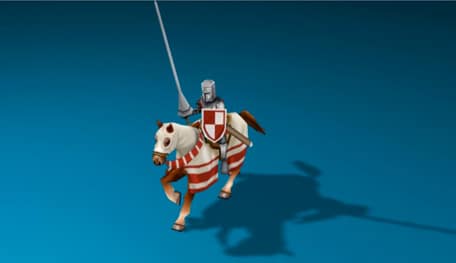
Q: Everything I read about game companies emphasizes the need for teamwork–a culture in which artists, programmers, and designers can all work together. Was Civ 5 a team effort?
In every way. Not a single asset in the entire game is the product of only one person. Every character was the result of a concept artist, a character artist, an animator, an effects artist, and the many programmers who wrote the engine that allows the characters to be rendered in real time. A well-designed and attractive game is the result of determined and talented people holding each other responsible for the quality of their work. It is hard to phone it in when you see how high your peers raise the bar every day.
Q: Other than Civ 5, what do you play in your spare time, if you have any? What games have blown you away this year, and why?
I am actually not very good at most games. I lose a lot. But I love Portal and Portal 2. The first Portal game was one of the most enjoyable gaming experiences I have ever had. Which may sound odd coming from an animator because, other than the few glimpses you get of your own character, it has little to no character animation in the game. But I loved that the voice acting alone created a very interesting character with GLaDOS. Portal 2 was a wonderful revisit to those feelings and excitement I got from the first game. Plus it was hilarious.
I am also a fan of 3rd person action adventure games like Ratchet and Clank. They are the games that give me the most satisfying gameplay feedback. I have never really enjoyed first person games in the past, but this year I have really been trying to give them another shot. I played through Bioshock and some of the newer Fallout games. I found that I enjoyed them more than I thought I would, but I am still really bad at them.
Q: Do you have any upcoming game projects with Firaxis that you’re able to tell us about?
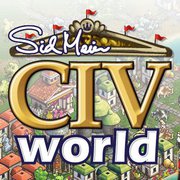
I have spent the last few months working on DLC for Civ 5. But we recently opened a Beta of a Facebook Civilization game called Civ World. I had never really played a Facebook game before, but I have to say I am really enjoying it. I have been told that it differs from other Facebook games in that it is actually a complex gaming experience. I have had to force myself to step away from Civ World more than once because I was not getting any work done. Oops…I think I just admitted to browsing Facebook at work. It’s…ummm…research.
Greg Marlow teaches game art and digital media courses at Sessions College. For more information about Sid Maier’s Civilization 5, you can visit civilization5.com.

Sessions Staff is a restless soul who loves to share Campus News stories with current and prospective students.

